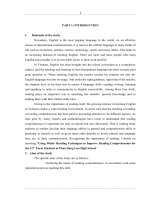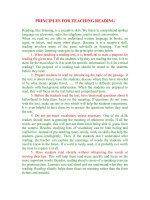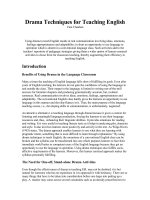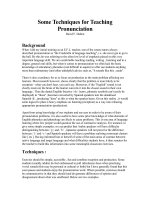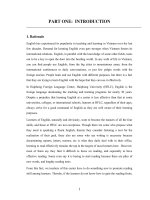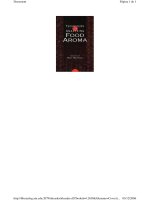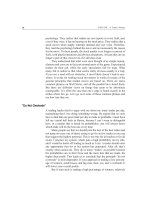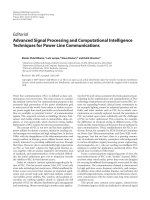TECHNIQUES FOR TEACHING READING COMPREHENSION ppt
Bạn đang xem bản rút gọn của tài liệu. Xem và tải ngay bản đầy đủ của tài liệu tại đây (347.73 KB, 33 trang )
TECHNIQUES FOR TEACHING
READING COMPREHENSION
Pre- & While-Reading Techniques
Post Reading Techniques
(Adapted from English Language Teaching Methodology-
BA upgrading course-The Ministry of Education & Training -2003)
Pre- & While-Reading
Techniques
1. OPEN PREDICTION
2. TRUE/FALSE
PREDICTION
3. ORDERING
PICTURES
4. MULTIPLE CHOICE
5. GAP- FILL
6. ORDERING
7. ANSWER GIVEN
8. PRE-QUESTIONS
9. GRIDS
10. MATCHING
11. COMPREHENSION
QUESTIONS
12. NETWORK
1. OPEN PREDICTION
(Description)
The teacher establishes a context and
introduces the topic of a reading text.
The students are required to guess what they
are going to read.
The teacher (or students) writes students’
guesses on the board.
The students are asked to read the text to
check if things they guess are correct or not.
1. OPEN PREDICTION
(Example)
Work with a partner to discuss the answers to the following questions
before you read the text “
Global Diet Choice
”
a. What are some meanings of the word ‘diet’?
b. Are fast-food places international? What types of
foods are common fast foods?
c. How do most people make decision about food and
diet?
d. What are some examples of diets based on location,
history, tradition, or religion?
e. How are diet choices becoming more alike around
global?
(Interactions I: Reading, Chapter 3, page 43)
2. TRUE/FALSE PREDICTION
(Description)
The teacher writes 5-10 statements about the
main points of a reading or listening text. Half
of the statements are true and the other half
are false.
The students are asked to work in pairs and
decide if the statements are true or false.
The teacher writes students’ guesses on the
board.
The students are asked to read the reading
text to check their answers.
2. TRUE/FALSE PREDICTION
(Example)
Before you read the text
“Tourism: the biggest business in the world”
(Tourism
1-Unit 1
page 10)
, discuss these statements with a partner. Write T (true) or
F (false).
a. One in fifty of all workers are employed in tourism
related industries.
b. The number of international tourism arrivals will be
more than double between 2004 and 2020.
c. Tourists often worry about international security.
d. Tourism has only had a good influence on the modern
world.
3. ORDERING PICTURES
(Description)
The teacher prepares some simple pictures to
describe a story or a text, and sticks them on
the board randomly.
Students work in groups to rearrange the
pictures and think of a story based on their
picture order. This activity is also used for while
techniques to check the ideas students have
heard or read about.
3. ORDERING PICTURES
(Example)
Look at the pictures and arrange them in a
logical order. Then, read the text
“Are we
alone in the universe?”
and check your
answer.
(Lifelines/Elementary
- Unit 12: Health - page 85)
4. MULTIPLE CHOICE
(Description)
The teacher prepares questions about
the ideas in the text. For each question,
there are three or four options for
students to choose from.
4. MULTIPLE CHOICE
(Example)
Read the text “
Child Prodigies
”
(New Interchange 2- Unit 12: It’s been a
long time! page 77),
then choose the best answer to each of the following
questions.
1. When did Sarah begin studying at the famous Juilliard School of Music?
A. 4 B. 5 C. 7 D. 8
2. How long did Michael finish his high school classes?
A. 4 years B. 3 years C. 2 years D. one year
3. What did Alexandra do at the age of 8?
A. became interested in art B. met Picasso
C. had her first art exhibition D. sold many paintings
5. GAP- FILL
(Description)
The teacher writes a short paragraph with several
blanks in it. The blanks can be lexical or
grammatical items or both. The more blanks the
paragraph has, the more difficult it is. If the
students are weak, words to fill in the blanks
should be provided. Students are required to work
in pairs, and then compare their answers.
Students write the words they guess on the
board.
5. GAP- FILL
(Example)
Read the text
“Getting more for less” (New interchange 2, Unit 5: Going
places - page 33)
and choose appropriate words in the text complete the
blanks in the following summary.
There are some ways to travel for less. First, buy cheap airplane ticket.
You can buy ……… plan tickets two or three months in advance. The
cheapest way is flying as …………,which costs as little 25% of the normal
fare. Another way is buying………….if you are going to do a lot of traveling.
Buying a single train pass gives you…… travel for a period of time. Train
passes are useful in India, ……… and European countries. Moreover,
staying in hostels when traveling may help you to save money. Not only do
hostels provide cheap…………., but nowadays they are also a great way to
meet new people.
6. ORDERING
(Description)
This technique is used for pre-reading or pre-listening.
The teacher writes about 6 or 8 statements on the
main points of a reading text, but the statements are
jumbled.
The students are asked to work in groups or pairs to
predict the order of the statements.
This technique is also used for while-techniques to
check the ideas students have heard or read about.
The teacher writes students’ guess on the board.
6. ORDERING
(Example)
Read the text about “Joan Chen” (New Interchange 2-Unit 1:
A time to remember- page 7) and arrange the following
events into the correct order according to the text.
She went to college in the United States and majored in
film.
She won the Golden Rooster, China’s top film award.
She has become famous since she starred in
The Last
Emperor
.
She was born and grew up in Shanghai in 1961.
She looked for work in Hollywood agents.
She was chosen to study at a film studio.
7. ANSWER GIVEN
(Description)
The teacher writes several answers on
the board. Students are asked to read a
text and make questions based on the
answers given.
7. ANSWER GIVEN
(Example)
Read the text
“Hip-Hop Fashions”
(New Interchange 1- Unit 9- page
59)
, then write the questions for the answers.
a type of urban music with heavy beat
African American kids in Detroit and Chicago
blouses and skirts with cartoon characters on
them
$ 100
8. PRE-QUESTIONS
(Description)
This technique is used for pre-reading.
The teacher writes a few questions on
the board. These questions should
focus on the main ideas of the reading
text. The teacher gives students a few
minutes to think about the questions.
Students are asked to read and answer
the questions. It doesn’t master if
students can’t guess correctly.
8. PRE-QUESTIONS
(Example)
Before you read the text
“National Parks” (Tieng Anh 10-
Unit 11- page 112-113),
work with a partner to answer the
following questions:
1. Have you ever been to a national park?
2. Can you name some of the national parks in
Vietnam and in the world?
3. What trees and animals can you see in a
national park?
9. GRIDS
(Description)
The teacher draws a grid on the board. The
grid will contain the main information of the
reading text. Students are asked to read the
text and fill in the gaps with information
taken from the text. Then they are asked to
write the information in the grid on the
board.
9. GRID(S) (Example)
Read the reading passage
“the story of my village”
(Tieng Anh 10-
Unit 8- page 82-83)
and complete the following table.
Area of changes
BEFORE NOW
House
Radio &TV
Farming
methods
10. MATCHING
(Description)
The teacher writes the main ideas of paragraphs
from the reading text on the board. Students
read the text and match these main ideas with
the number of the paragraph.
OR: The teacher writes the main/essential ideas
from the reading text and several details related
to the main ideas. Students read the text and
connect the main ideas with the details.
10. MATCHING
(Example)
Read the text
“Education: A Reflection of Society”
(Interactions II /
Reading- chapter 1/part I - page 7-9)
. Match the paragraphs with topics
below. Write the letters of the paragraphs on the lines.
1. __________ Conclusion: Education as a reflection of society
2. __________ A country that places a lot of importance on
education and makes students take difficult exam.
3. __________ A country that offers education to everyone but also
has problems in its school.
4. _________ A country where equality and national unity are
important
5. __________ A country where social class is very important
6. __________ Introduction: Education as a mirror of a culture
11. COMPREHENSION QUESTIONS
(Description)
These questions are related to the main
ideas of a reading text to check students’
comprehension. Students work individually
or in pairs to answer questions from the
teacher or from the textbook. Students are
encouraged to check and compare the
answer before the teacher gives feedback.
11. COMPREHENSION QUESTIONS
(Example)
Read the text
“People’s background”
(Tieng Anh 10-
Unit 3- page 32-33)
and answer the questions below.
1. When and where was Marie Curie born?
2. What kind of student was she?
3. Why did she work as a private tutor?
4. For what service was she awarded a Nobel Prize in
Chemistry?
5. Was the prize her real joy? why/ why not?
12. NETWORK (Description)
This can be used for students to brainstorm in
the pre-reading stage. The teacher writes the
network on the board.
Students are required to work individually to find
ideas related to the topic of the network and
then compare their answers in pairs or groups,
and then the teacher collects the ideas from the
students.
